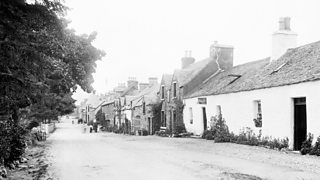The Telegram
- Created by: craiggordon12
- Created on: 26-08-17 13:43
The story is set in a small Scottish rural community during World War Two. It opens with the two main characters, a fat woman, Sarah and a thin woman drinking tea and gazing out of the window.
The village appears sleepy and quiet but it becomes clear the impact of war is felt just as keenly here as in any other community in the British Isles. The villagers dread the arrival of the telegram of the title, which brings the news of a son killed in the conflict.
These telegrams are delivered by a local church elder. Residents of the village have come to fear the sight of this black clad figure stopping at their door.
The women notice the elder as he walk through the village. He clutches one of the telegrams, which is immediately recognisable for its distinctive yellow colour. The women become increasingly fearful as he makes his way closer to their houses, the last two in the village. Their mounting tension and sense of dread provokes an interesting conversation.
Although they are neighbours, these women are not friends. There are many underlying tensions in their relationship. The fat women considers her neighbour an outsider and a snob, even though she has lived in the village for more than thirty years and survives on a tiny widow’s income.
She is jealous that the thin woman’s son has been to university and is an officer in the navy. Her own son is merely an ordinary seaman.
The thin woman is contemptuous of most of the other mothers in the village. She believes they could have worked harder to provide a better education for their own children.
As the elder approaches the final two houses in the village it seems certain that the telegram is meant for one of them.
He passes the fat woman’s house and the letter seems destined for the thin woman. At this moment, that fat woman suddenly understands the years of sacrifice endured by her neighbour for her son.
However, in an ironic twist, instead of turning in at the thin woman’s house, the elder keeps walking. It later emerges that the telegram was addressed to the elder himself. So shocked by the news and unable to face telling his wife their son had drowned, he walks six miles to the next village before he is finally stopped, still clutching the crumpled, yellow piece of paper.
Characterisation and setting
Crichton Smith is deliberately sparse with details of the location and characters. This anonymity helps to emphasise the universal impact of war.
We can deduce the time from the reference to the Bismarck, a German warship sunk by the Allies during World War Two. A sense of place is created by the use of distinctly Scottish names like Roddyand MacLeod. The mention of the mailboat reveals that this is an island community.

The village itself is described as bare, superstitious and with little colour. This bleak, uninviting environment is reflected in the inhabitants of this island community.
The fat woman, Sarah, represents…
Comments
No comments have yet been made